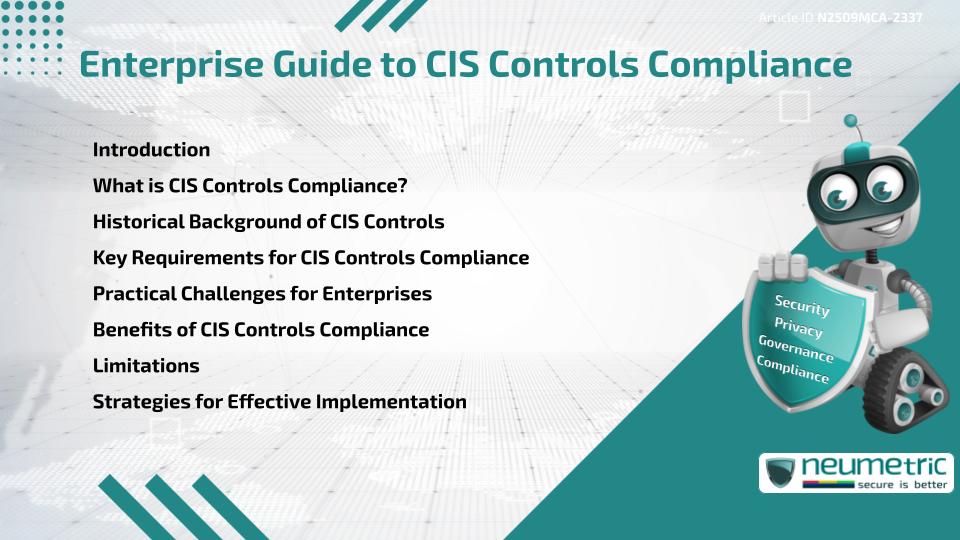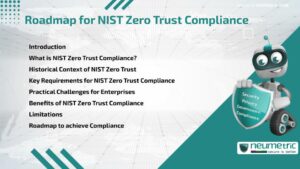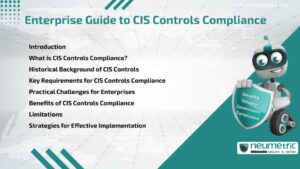Table of Contents
ToggleIntroduction
CIS Controls Compliance is an important Step for Enterprises aiming to Strengthen CyberSecurity & Reduce Risks. Developed by the Center for Internet Security [CIS], these Controls provide prioritised Best Practices for protecting Systems, Data & Networks. For Enterprises, adopting & maintaining Compliance with CIS Controls ensures alignment with Global Standards, simplifies Audits & Builds stronger Resilience against Cyber Threats.
What is CIS Controls Compliance?
CIS Controls Compliance refers to the implementation & verification of CIS recommended Security Measures across Enterprise IT Environments. The Controls are grouped into Basic, Foundational & Organisational categories, helping organisations prioritise Security Actions. Compliance demonstrates that Enterprises are following Industry recognised practices to Safeguard Sensitive Information.
Historical Background of CIS Controls
The CIS Controls, originally introduced in 2008 as the “Consensus Audit Guidelines,” were developed to address common CyberSecurity Threats. They were created through collaboration among Government, Private Industry & Academic Experts. Over time, the Controls evolved to reflect changing Threat landscapes, including Cloud Security & Mobile Device Management. Today, they are widely recognised by Regulators & Referenced by Frameworks such as NIST & ISO 27001.
Key Requirements for CIS Controls Compliance
To achieve Compliance, Enterprises must focus on:
- Inventorying & Controlling Hardware & Software Assets
- Implementing Continuous Vulnerability Management
- Enforcing secure Configuration of Systems & Applications
- Managing Access Controls & Administrative Privileges
- Establishing Incident Response & Recovery Processes
- Conducting regular Audits & Training for Staff
Detailed Resources are available from the Center for Internet Security.
Practical Challenges for Enterprises
Enterprises often face difficulties when implementing CIS Controls. Large organisations with complex IT Environments may struggle with Asset visibility. Budget & Resource Constraints can limit the ability to adopt advanced Controls. Additionally, enforcing Compliance across Global Operations may involve aligning with multiple Regulatory Frameworks simultaneously.
Benefits of CIS Controls Compliance
Despite these challenges, Compliance offers significant benefits:
- Reduced exposure to common Cyber Threats
- Stronger alignment with Industry Standards & Regulatory Audits
- Improved Incident Detection & Response Readiness
- Greater trust among Customers, Partners & Regulators
- Long-term cost savings by reducing the Likelihood of Breaches
Limitations
Some argue that CIS Controls can be too prescriptive, limiting flexibility for unique business Environments. Others highlight that Compliance alone may foster a checklist mentality rather than genuine Security improvements. Moreover, small & mid-sized Enterprises may find it difficult to adopt the full Framework without External Support.
Strategies for Effective Implementation
To succeed with CIS Controls Compliance, Enterprises should:
- Conduct Gap Assessments to identify Areas of Weakness
- Prioritise implementation of basic Controls before advancing to complex ones
- Use Automated Tools for monitoring & reporting Compliance
- Provide regular Training to Staff on CIS principles & Security Awareness
- Align CIS Controls with broader Frameworks such as OECD Privacy guidelines & World Bank Governance insights
Takeaways
CIS Controls Compliance provides Enterprises with a Practical Roadmap to strengthen CyberSecurity & Governance. By adopting & integrating these Controls into Operations, organisations can reduce Risks, improve trust & enhance Readiness for Regulatory Audits.
FAQ
What is CIS Controls Compliance?
It is the adoption & verification of CIS recommended Security Practices across Enterprise IT Environments.
Why is Compliance important for Enterprises?
It strengthens Security, reduces Risks & Aligns with Global Frameworks.
What challenges do Enterprises face?
Challenges include Resource Constraints, Asset visibility & aligning Global Operations.
Does Compliance guarantee full protection?
No, but it significantly reduces Risks when combined with broader Governance Practices.
How can Enterprises achieve Compliance effectively?
By prioritising basic Controls, using Automation & Integrating CIS Practices into daily Operations.
References
- Center for Internet Security
- NIST CyberSecurity Framework
- ISO 27001 – Information Security
- ENISA – European Union Agency for CyberSecurity
- OECD Privacy Guidelines
Need help for Security, Privacy, Governance & VAPT?
Neumetric provides organisations the necessary help to achieve their CyberSecurity, Compliance, Governance, Privacy, Certifications & Pentesting needs.
Organisations & Businesses, specifically those which provide SaaS & AI Solutions in the Fintech, BFSI & other regulated sectors, usually need a CyberSecurity Partner for meeting & maintaining the ongoing Security & Privacy needs & requirements of their Enterprise Clients & Privacy conscious Customers.
SOC 2, ISO 27001, ISO 42001, NIST, HIPAA, HECVAT, EU GDPR are some of the Frameworks that are served by Fusion – a SaaS, multimodular, multitenant, centralised, automated, CyberSecurity & Compliance Management system.
Neumetric also provides Expert Services for technical Security which covers VAPT for Web Applications, APIs, iOS & Android Mobile Apps, Security Testing for AWS & other Cloud Environments & Cloud Infrastructure & other similar scopes.
Reach out to us by Email or filling out the Contact Form…





